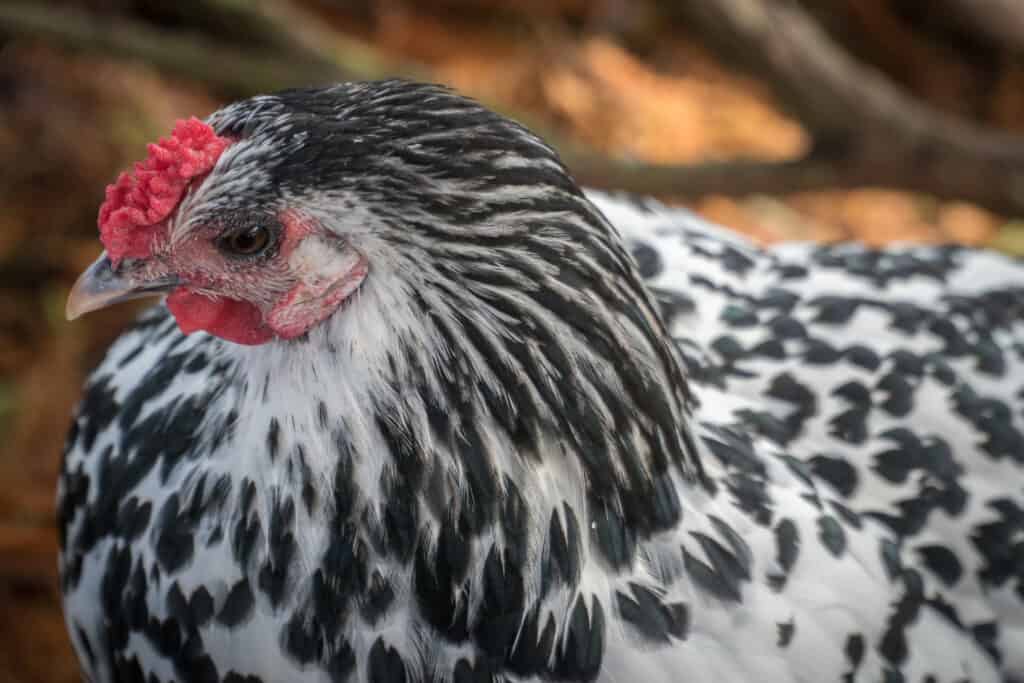Hamburg Chicken
Gallus
This breed doesn't usually make nests or incubate their own chicks.
Advertisement
Hamburg Chicken Scientific Classification
- Kingdom
- Animalia
- Phylum
- Chordata
- Class
- Aves
- Order
- Galliformes
- Family
- Phasianidae
- Genus
- Gallus
- Scientific Name
- Gallus
Read our Complete Guide to Classification of Animals.
Hamburg Chicken Conservation Status
Hamburg Chicken Facts
- Prey
- Just about anything they can get
- Main Prey
- Insects
- Name Of Young
- Chicks
- Group Behavior
- Flock
- Fun Fact
- This breed doesn't usually make nests or incubate their own chicks.
- Estimated Population Size
- The Livestock Conservancy lists this breed as threatened.
Hamburg Chicken Physical Characteristics
- Color
- Brown
- Grey
- Red
- Blue
- Black
- White
- Gold
- Tan
- Dark Brown
- Cream
- Orange
- Skin Type
- Feathers
- Aggression
- Low
View all of the Hamburg Chicken images!
The Hamburg Chicken originated in Holland sometime around the 14th century.
This chicken is small and matures quickly. Farmers typically consider them good egg producers, primarily for which they are used.
3 Amazing Hamburg Chicken Facts
- Beautiful feathers: These birds are known for their beautiful feathers, which typically translates to them being very good show birds. While they are also kept as egg layers, it isn’t uncommon for them just to be bred for their looks.
- Room to roam: The Hamburg Chicken requires high fences and extra space to roam, as they tend to be quite flighty. They’re known for roasting in hedgerows and at the tops of trees.
- Rare birds: The Hamburg chicken isn’t as common as other breeds. Therefore, if you want to add them to your homestead, you’ll have to spend a lot of time looking for them.
Where to Find Hamburg Chickens
Initially, these birds came from Holland, hence their name. Today, though, they can be found all over the world. Still, due to their rarity, finding them can be extremely difficult. You typically have to do a lot of research to find a breeder that currently has eggs available. Travel may be necessary.
Still, a quick look online will reveal quite a few breeders. Because these chickens are rarer, you’ll need to pay more than average for fertilized eggs. Plus, you’ll often have to wait until eggs are available. Usually, suppliers have waitlists. However, other times, you’ll simply have to check back regularly and jump to purchase chicks when they become available.
Nests
Hamburg chickens do not tend to go broody. In other words, they usually don’t sit on eggs or make nests. You can’t count on these chickens to make their own nests or incubate their own chicks.
If you aren’t planning on incubating your own chicks, this is likely a good thing. However, if you are, you should probably select a different chicken breed.
Scientific Name
The Hamburg chicken is just another breed of chicken. However, it doesn’t belong to its own species. Therefore, it has the same scientific name that all other chickens have.
It belongs to the genus Gallus, also known as Junglefowl. These birds occur throughout South and Southeast Asia, where they diverged from other species around six million years ago. These birds are larger and typically do not fly. The males often have colorful plumage, though this isn’t always the case.
All chickens belong to the Phasianidae family, which contains ground-living birds. The partridge, peafowl, and similar birds all belong to this family.
Size, Appearance, and Behavior
The Hamburg chicken only weighs between 1.6 to 1.8 kg. They have very slender legs and a neat rose comb. Typically, they are considered smaller birds when compared to other chickens.
This breed varies a lot in coloration. In total, there are 11 recognized colorations in Germany and Holland, where the bird is from. However, only six of these are included in the American standard. Therefore, these birds appear to vary more in Europe than they typically do in the States. Much of this may be due to the birds that were imported into America.
Furthermore, there are also slightly different-sized Hamburg chickens. Pencilled breeds (those with a particular lace-like plumage pattern) are the smallest, for instance. You can even find Bantam Hamburgs in some cases.
Typically, Hamburg chickens can be used for both beauty and egg-laying. They remain extremely cold-hardy, though the same could not be said for the heat. Usually, this breed moves a lot more than others, so they require more room.
Because they are so active, they are also a great foraging breed. Many of their calories can be found by the chicken if they are allowed to roam. However, they do need a good amount of area to graze, as they tend to have a larger wandering radius. You can also keep them in a run. However, it will have to be larger than average.
Furthermore, these birds become bored more easily than most. Letting them free-range is the best way to prevent this. However, these birds are flighty and will wander off. Therefore, you’ll need a fence to keep them on your property.

In Germany and Holland, there are 11 recognized colorations of the Hamburg chicken, but in the U.S. there are only 6.
©AGCreations/Shutterstock.com
Diet
The Hamburg chicken eats the same food that other types of chickens eat. However, they are excellent foragers and can locate many of their calories themselves. When allowed to free range, they will eat the tops of grass, other plants, and insects. In fact, they can consume a lot of protein from insects alone.
On top of this, you’ll likely have to provide them with some feed. The best option is to provide them with a feed designed for chickens.
What Does the Hamburg Chicken Eat?
You don’t need to feed a Hamburg chicken anything special. However, you may need to feed them less than other birds when allowed to wander, as they are excellent foragers. Any food that is designed for chickens should work for this breed. Generally, they will try to eat just about anything they can find.
Predators, Threats, and Conservation Status
Hamburg chickens are prone to predation by the same animals that typically eat chickens. Generally, this will depend on the location the chicken is in. For instance, if coyotes are a problem in your area, they could eat your chickens. Wild animals aren’t the only problem, though, cats and dogs can also injure and eat chickens.
Because this is a domestic species, it is not granted a conservation status like wild animals. However, the Livestock Conservancy does list this breed as threatened. It isn’t the most critical heritage breed, but its numbers are reducing. Typically, this is due to availability. These chickens simply aren’t as widely available as other breeds, so their numbers continue to drop.
What Eats Hamburg Chickens?
Any small predators in your area can prey on your chickens, including the Hamburg. These chickens are very similar to others in terms of predation. They do not have any extra defense mechanisms or behaviors that help them stand up to predators. Therefore, they do require quite a bit of protection.
The exact predators that attack your chickens will depend on your area. Not all common predators are native everywhere. Foxes, coyotes, weasels, bobcats, birds of prey, opossums, raccoons, rodents, snakes, and skunks can all prey on chickens.
Usually, younger chickens are more at risk. Providing nighttime, predator-proof housing can be beneficial, as many of these predators primarily hunt at night.
Reproduction, Young, and Molting
Because the Hamburg chicken does not hatch their own young, the eggs are typically incubated. Often, an electronic incubator is utilized. However, some breeders may also use other chickens to incubate their Hamburg eggs. Most chickens aren’t picky about which eggs they lay on.
Hamburg chickens mature slightly faster than other chickens. Therefore, they start laying eggs at a very young age. Once they have reached maturity, a single chicken lays about 210 eggs per year. Therefore, they are typically utilized as egg-laying birds.
Beyond that, these chickens are extremely similar to other breeds.
Population
It is challenging to determine how many Hamburg chickens there are worldwide. Typically, there is no census that keeps track of this breed. The Livestock Conservancy is currently performing a domestic poultry census. However, it is not yet completed.
View all 104 animals that start with HHamburg Chicken FAQs (Frequently Asked Questions)
Does the Hamburg chicken migrate?
No. As a domestic breed, this chicken does not migrate. However, they are very active compared to other breeds.
How many eggs does the Hamburg Chicken lay?
Usually, this chicken lays about 210 eggs per year. Therefore, they are considered pretty prolific egg layers.
How fast does the Hamburg chicken fly?
While the Hamburg does fly better than other breeds, it does not fly particularly fast or well. We don’t have an exact measurement on the speed, however. Still, this is a chicken, making it largely a ground-living bird.
What is a Hamburg chicken's wingspan?
While the Hamburg’s wings are usually considered larger than most chickens, we do not have exact measurements for their wings. Typically, they do not use their wings for flying, as they are ground-living birds.
When do Hamburg chickens leave the nest?
Hamburg chickens usually do not build nests, as they do become broody. Therefore, babies are often incubated by their owners.
Thank you for reading! Have some feedback for us? Contact the AZ Animals editorial team.
Sources
- Wikipedia, Available here: https://en.wikipedia.org/wiki/Hamburg_chicken
- McMurray Hatchery, Available here: https://www.mcmurrayhatchery.com/silver_spangled_hamburgs.html
- Roys Farm, Available here: https://www.roysfarm.com/hamburg-chicken/
- Ohioline OSU, Available here: https://ohioline.osu.edu/factsheet/vme-22
- Livestock Conservancy, Available here: https://livestockconservancy.org/heritage-breeds/2021-poultry-census/

















